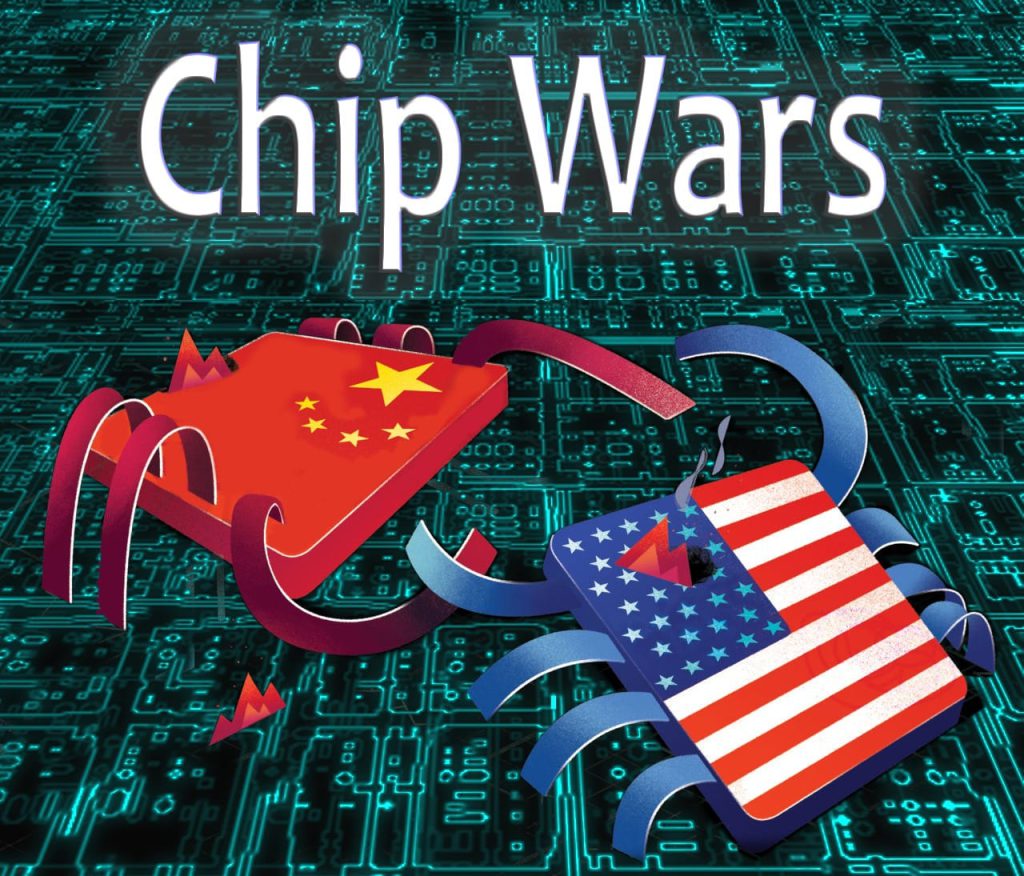
AMD vs Intel: Who Will Dominate the Future of Chip Technology?
Updated may 2023
The battle for supremacy in the world of microprocessors has been a long-standing rivalry between two tech giants: Advanced Micro Devices (AMD) and Intel. This competition, often referred to as “AMD vs Intel,” has shaped the trajectory of the technology industry for decades. The question on everyone’s mind is: who will dominate the future of chip technology?
The Latest Chip Technology
AMD has been making significant strides in the realm of the latest chip technology. The company’s Zen 4 CPUs, launched in November 2022, have been lauded for their performance and efficiency. These chips, built on a 5nm process, offer a significant leap in power efficiency and performance per watt compared to their predecessors.
On the other hand, Intel has been focusing on its 11th and 12th-generation chips, built on a 10nm process. The company’s Alder Lake processors, which utilize a hybrid architecture combining high-performance cores with high-efficiency cores, have been well-received in the market. However, Intel’s chips are still built on a larger process node than AMD’s, potentially impacting their performance and power efficiency.
AMD vs Intel: Erosion of Intel’s Market Share
Recent market data indicates that AMD has been steadily eroding Intel’s market share. According to a report by Mercury Research, AMD’s market share in the x86 CPU market increased from 27.7% in Q1 2022 to 34.6% in Q1 2023. This growth has been driven by the success of AMD’s Ryzen desktop CPUs and Epyc server processors, which have been gaining traction for their performance and value proposition.
Intel’s Response
In response to AMD’s growing market presence, Intel has been doubling down on innovation and strategic partnerships. The company’s upcoming Sapphire Rapids server processors, built on Intel 7 process technology, are expected to deliver a significant performance boost over their predecessors. Intel is also investing heavily in its foundry services, aiming to manufacture chips for other companies, which could provide a new revenue stream and bolster its competitive position.
Who Will Win the Battle?
Predicting the outcome of the AMD vs Intel battle is complex, as it depends on numerous factors, including technological advancements, market dynamics, and strategic decisions by both companies. However, industry experts believe that the competition will likely intensify in the coming years.
AMD’s aggressive innovation strategy and its success with the Zen architecture have positioned it well for future growth. The company’s focus on high-performance computing, gaming, and data centers could drive further market share gains.
On the other hand, Intel’s vast resources, deep industry relationships, and comprehensive product portfolio should not be underestimated. The company’s investments in new technologies, such as AI and autonomous driving, could open up new growth avenues.
In conclusion, the AMD vs Intel battle is far from over. Both companies have their strengths and are making strategic moves to secure their future. The competition between AMD and Intel will continue to drive innovation in the chip industry, benefiting consumers and businesses. As for who will dominate, only time will tell. However, one thing is sure: the race is on and more exciting than ever.
Google, the behemoth, joins the AMD vs Intel Foray
The dynamics of the AMD vs Intel battle are set to become even more enjoyable with Google, the tech titan, entering the fray. Google’s relationship with AMD has been strengthening, with the tech giant already choosing AMD to supply GPUs for its Stadia gaming service.
Intel was initially slated to provide the chips for this service, but further chip delays have potentially opened the door for AMD to deepen its relationship with Google. Analysts speculate that Google could embrace AMD’s Epyc 2 “Rome” processors based on the Zen 2 microarchitecture. Given that Google operates millions of servers, this could lead to a significant profit boost for AMD.
What sets AMD’s Epyc 2 processors apart from Intel’s offerings? These chips leverage 7nm technology, and each chip can house up to eight more minor 7nm chips. This allows a single Epyc 2 processor to have 64 cores and execute 128 threads. The data center processing industry is closely monitoring these chips, and if a major player like Google adopts them, many others will likely follow suit. In an era where AI-based technology is rapidly gaining traction, no one wants to be left behind.
However, it’s important to note the use of the word “could” in this context. Analysts commonly use This tactic to present a potential scenario without asserting it as a certainty. As such, while the prospect of Google favoring AMD over Intel is intriguing, it remains a speculative scenario at this point.
TSMC’s Technological Leap: Cementing its Lead Over Intel
Taiwan Semiconductor Manufacturing Company (TSMC), the world’s largest dedicated independent semiconductor foundry, has been making significant strides in chip technology. TSMC’s advancements in 5nm and 3nm process technologies have positioned it at the forefront of the semiconductor industry, outpacing Intel in terms of technological innovation.
Intel’s Struggles and TSMC’s Rise
Intel, once the undisputed leader in chip manufacturing, has been grappling with delays and setbacks in its transition to 10nm and 7nm process technologies. These challenges have allowed TSMC to surge ahead. TSMC’s 5nm chips are already in mass production, powering devices like Apple’s iPhone 12 and M1 Macs. Meanwhile, the company’s 3nm chips are on track for production in 2022, promising even greater performance and efficiency.
TSMC’s Strategic Partnerships
TSMC’s lead over Intel is further cemented by its strategic partnerships with tech giants like Apple, AMD, and Nvidia. These partnerships have boosted TSMC’s revenues and reinforced its position as a leading chip manufacturer. The trust these tech giants place in TSMC’s manufacturing capabilities speaks volumes about its technological prowess and reliability.
The Future of Chip Manufacturing
Looking ahead, TSMC’s lead over Intel could widen even further. TSMC has announced plans to invest $100 billion over the next three years to expand its manufacturing capacity and advance its technology. This ambitious investment underscores TSMC’s commitment to maintaining its lead and meeting the growing demand for advanced semiconductors.
In contrast, Intel’s future in chip manufacturing is less specific. The company has announced plans to outsource some of its chip production, which could benefit TSMC. However, Intel is also investing in its manufacturing capabilities, with plans to launch a new business unit, Intel Foundry Services, to manufacture chips for other companies.
TSMC’s Ambitious Leap: Aiming for 1nm Technology
Taiwan Semiconductor Manufacturing Company (TSMC), a global leader in the semiconductor industry, is known for its relentless pursuit of technological innovation. The company’s ambitious goal to reach 1nm process technology is a testament to this pioneering spirit.
The race to 1nm is a significant milestone in the semiconductor industry. Achieving this would mean creating transistors so small that they’re measured on the atomic scale. TSMC’s pursuit of 1nm technology underscores its commitment to pushing the boundaries of what’s possible in chip manufacturing.
TSMC’s Technological Roadmap
TSMC’s 3nm chips are set to enter mass production in Q4 2022, with an upgraded version (N3E) starting commercial production in H2 2023. The company’s 2nm chips are expected to be available by 2025. TSMC is currently in the pathfinding stage for manufacturing technologies beyond the 3nm node. However, the company is already working on 1nm technology, with a new factory expected to be prepared by mid-2026, first trials to start in 2027, and mass production release expected in 2028.
Challenges and Opportunities
Reaching 1nm technology is not without its challenges. As transistors shrink, issues such as quantum tunneling, power leakage, and heat dissipation become increasingly complex to manage. However, TSMC’s track record of overcoming technological hurdles to achieve smaller process nodes suggests that the company is well-equipped to tackle these challenges.
The impact of achieving 1nm technology would be profound. Chips manufactured using 1nm process technology would offer unprecedented levels of performance and power efficiency. This could revolutionize a range of sectors, from consumer electronics to high-performance computing and artificial intelligence.
As transistors become smaller, the process of manufacturing them becomes more complex. Intel, for example, will not go directly from 4nm to 2nm. It will move from 4nm to 3nm to 2nm and then embrace a new naming scheme where the process tech will use Angstrom. Simply put, 10a or 10 angstrom means 1nm. Therefore, Intel will not jump from 2nm to 1nm. It will go from 2nm (20a) to 18a and forward, and a similar situation is expected from TSMC.
Even minnows are now attempting to take on INTC:
Rene James, the former number two at Intel, currently heads a start-up called Ampere that is going after Intel’s dominant Server chip business. Her exact words, “It’s a once-in-a-50-year situation,” but here’s the rub, it is using TSM to build those chips, and it has already produced data centre chips that Lenovo and a few other server-based companies have selected. This is probably the very start of a new megatrend; time will tell how fast this trend gathers traction.
While Amazon is using AMD’s chips, it is also designing its chip called the Graviton, and it would never have managed this without TSM capabilities. AMZN is the largest cloud company in the world, so that’s another thorn for Intel; a price war is brewing which will further erode Intel’s margins as it struggles to hold onto market share. Therefore it is possible that INTC could lose up to 20% of its current market share to its competitors and possibly more if the masses think nothing is being done to address its shortfalls. There is still time for Intel to remedy the situation (taking a long-term view), but it needs to start acting decisively soon.
AMD vs Intel: Conclusion
Can we state with certainty that AMD and TSM have won the battle?
If you start with the wrong premise, no matter how hard you try, the answer will be wrong. AMD does not have its Fabs, which means it’s at the mercy of TSM. TSM could start to charge AMD whatever it wants (in theory), and this would affect AMD’s bottom line. In the end, the relationship between AMD and TSM is one in which TSM holds all the crucial cards for now; designing great chips means nothing if you do not control the means of production.
The real story is the battle between TSM and Intel, and in that arena, TSM is leading for now, and if the US government does not start to support essential players as is the case in China, then this could mark a turning point. While TSM is a Taiwanese company, China has its hands in that pie too, and you will see why as the article below addresses this issue.
TSM vs INTC Appears To Be The Real Issue
If TSM remains the dominant player, then sooner or later, this technology will make its way to China. China’s government supports key industries, semiconductors, 5G, etc., and this is what is enabling them to advance at such a rapid pace. Unless The US starts to take a similar stance, it is just a matter of time before China wins the 5g wars (which it appears to have won already as Huawei so far has the best 5g hardware on the market) and the semiconductor wars. China is already poaching talent from TSM and other Taiwanese chip-based companies at a rapid clip.
Throughout this article, we used the word could, and might several times; we could have easily opted for the word “will” or something more forceful, but injecting emotions into the game plan is a surefire way to guarantee a loss. Every situation should be treated the same way; examine the data in a cool, calm and rational manner.
The crowd follows those it believes to be the leader; if the perception of leadership is challenged, the leader’s image suffers irreparable damage over the short to intermediate time frames. The former leader has to move fast to contain the damage; if not, the damage is usually permanent.














